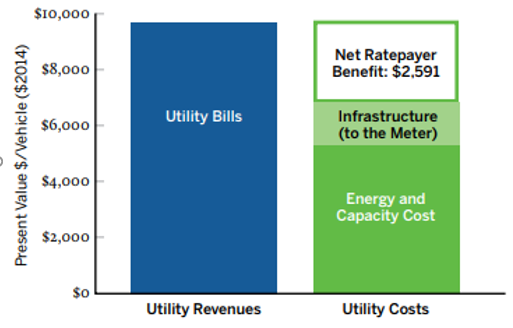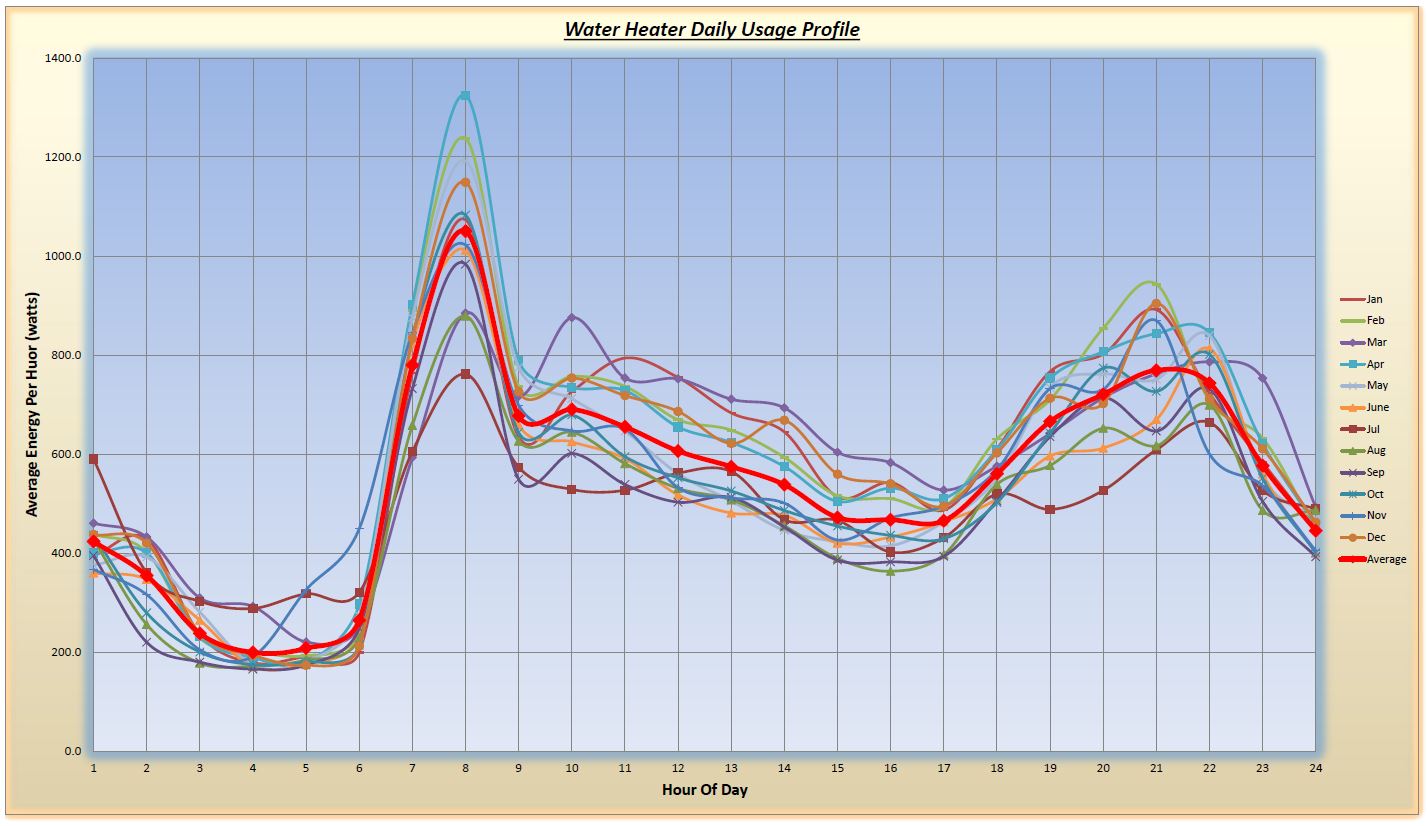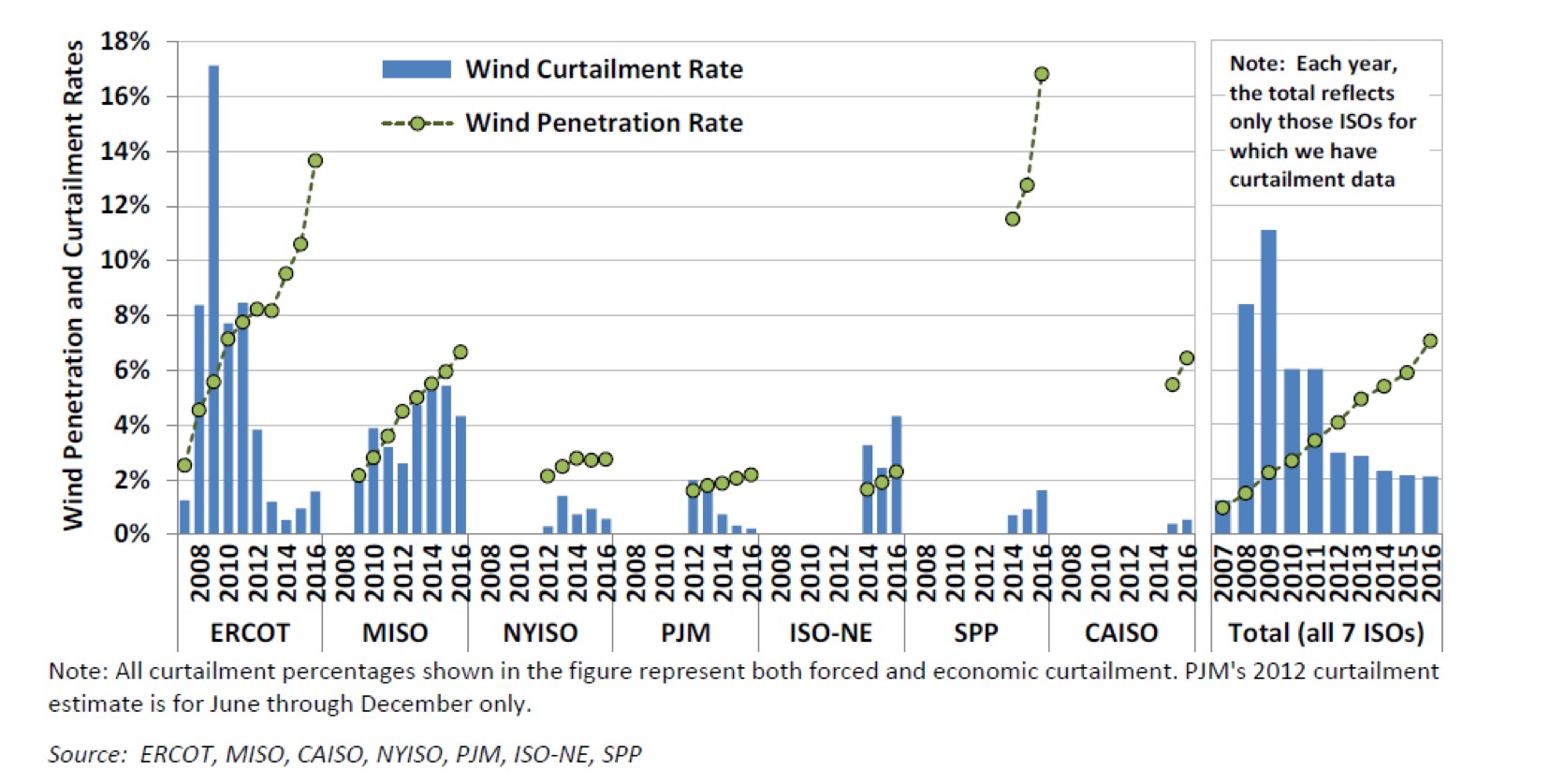Imagine you are preparing dinner for guests arriving at 6 p.m. when you learn that they’ve been delayed. And imagine that, instead of keeping the food hot, you had to throw all of it away and start cooking again for the actual time they come in the door. Wasteful and unacceptable, right? If you are an electric utility providing energy for consumption at a specific time and the demand isn’t there, that’s exactly what you have to do: throw it away.
The obvious difference between these two examples is the ability to store food in one case and the inability to store energy in the other. If guests don’t show up, the cook simply puts the dinner in the fridge for later consumption. But in the power system, if the demand for electricity, or “load,” is not there, the grid manager often has to “curtail” generation—i.e., throw it away. Lawrence Berkeley National Laboratory reports that in 2016 across the country’s seven organized wholesale markets, grid operators, on average, threw away about 2 percent (and in several cases over 4 percent) of electricity from variable renewable energy resources like wind and solar, because the demand for it wasn’t there when the energy was available. As those clean resources become cheaper and cheaper, wasting them probably makes even less economic sense.
How can we avoid wasting this low-cost energy? One good way is through beneficial electrification. Some electrified end uses—like charging electric vehicles and heating water—don’t require electricity from the grid at the moment they are used. Therefore, much of the new load added to the system by these uses is inherently flexible and can serve as energy storage. As a result, the power system can reduce curtailment and serve that flexible load at cleaner and less expensive times of the day. Let’s look at these end uses and consider how they can give grid managers greater flexibility in optimizing their systems.
Electric Vehicles (EVs): Potential to Cut Costs for Everyone
EVs constitute a significant source of flexible load because the batteries that power them can be charged whenever is most beneficial to the grid. This flexibility means that EVs can actually improve the utilization of the transmission and distribution system, shifting loads that would otherwise add to system peaks, which ultimately drive grid investment and increase cost. The need for system upgrades can be minimized if EVs are charged during off-peak periods, either through smart charging, time-of-use pricing, or some combination of both. EV charging flexibility also provides the potential for vehicle-to-grid (V2G) services or two-way charging, which essentially allows for an EV’s battery to serve as a storage device available to discharge power back onto the grid when called upon.
Adding EV load can also contribute to lowering the average cost to serve all customers, not just EV owners. Analysis of EV adoption scenarios in California by Energy and Environmental Economics (E3) found that there can be significant utility system benefits from adding EV charging load to the grid. E3 found that utilities’ cost to serve the load added by substantial EV adoption was less than the amount of revenue they would bring in from customers charging EVs, thereby reducing the cost of providing electricity for all ratepayers.
Utility System Costs and Benefits from EV Charging in California

Source: RAP
Water Heating: Load-Shifting and Ancillary Services
Uncontrolled residential water heating usage usually peaks in the morning and evening hours, when consumers start and end their days. The figure below characterizes typical residential hot water heater electricity usage for an upper Midwest state, by hour of the day and month of the year. From a grid management point of view, this demand trend occurs at different times of the day from typical solar production (mid-day) and the most common wind production (overnight). This means that flexible water heater load can be moved off-peak to “charge” water heaters during cheaper and lower-emitting hours.
Water Heater Usage from the Upper Midwest

Source: Steffes Corp.
Electric resistance water heaters (ERWHs) and heat pump water heaters (HPWHs) are examples of this flexibility. Because the water tank of an ERWH can typically store a full day’s supply of hot water, it doesn’t matter when it is charged. Its energy use can be curtailed during peak, daytime hours and that load can be concentrated into low-cost (and low-emission) hours of the day. Heat pump water heaters can also be controlled to provide load-shaping and capacity benefits to the system.
In addition to load shifting, flexible electrification load can help in providing “ancillary services,” another category of tools used by grid managers to ensure power system reliability and meet operational requirements. Smart electronics and improved communications are creating a new category of responsive appliance resources that enable grid managers to control the heating elements of ERWHs in very short increments for various uses.
This flexibility allows a utility or aggregator to provide valuable ancillary services to the grid, such as frequency regulation (a transmission-level service) or voltage support (a distribution-level service), to help ensure that the grid operates efficiently and reliably. Because HPWH compressors are mechanical devices that could suffer unacceptable wear if controlled down to the sub-minute periods required for fast-response services, they are not currently suited to provide fast-response benefits.
Space Heating: Tapping the Smart Thermostat
The electrification of space heating—where technologies have previously relied on fossil fuels—also holds great promise. When connected with smart thermostats, for example, air source heat pumps can help manage system demand by preheating a space during the afternoon hours and running less during the early evening peak. Smart thermostats can enable demand response programs whereby a utility can reduce the electric load of a group of heat pumps by an individually small amount. Taken as a whole, these reductions can provide a measurable peak load reduction benefit to the grid and also reduce air emissions.
Waste Not, Want Not
As we have noted in our publications, for electrification to be considered beneficial, it should meet one or more of the following conditions without adversely affecting the other two:
- Saves consumers money over the long run;
- Enables better grid management; and
- Reduces negative environmental impacts.
The flexibility enabled by electrifying end uses constitutes a new tool and source of value for managing electricity grids. For consumers, smart charging programs featuring time-of-use rates can provide the exact same service but at less expense and often with cleaner electricity. For system operators, flexible loads represent the opportunity to have greater control of the power system by shaping demand, and to optimize system efficiency by enabling greater use of existing resources.
The chart below shows the penetration of wind resources in ISOs around the United States, and also their curtailment between 2008 and 2016.
Wind Curtailment and Penetration Rates by ISO

Source: U.S. Department of Energy
By moving flexible electrification load to times when these resources are being curtailed, grid managers could charge EVs and operate space and water heating heat pumps using the thousands of GWhs currently being wasted. By moving load to times when it can be served by cleaner, cheaper resources and avoid system peaks, grid operators can save money and emissions over time—both for themselves and ultimately for ratepayers.
In short, by fully engaging the flexibility of newly electrified loads on the power system, grid operators can “toss out dinner” a little less often and reduce the waste of valuable energy resources.
_____
This is the second in a series of RAP blogs exploring aspects of beneficial electrification.

